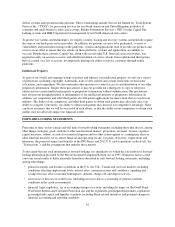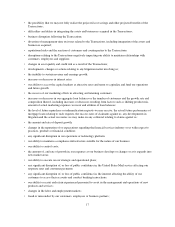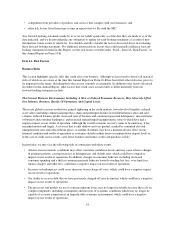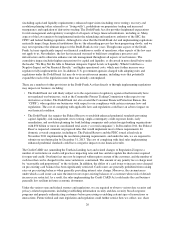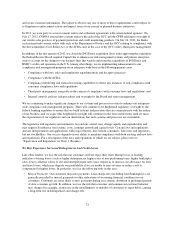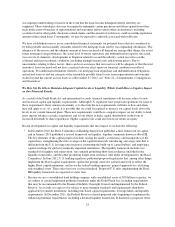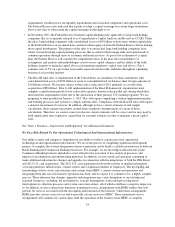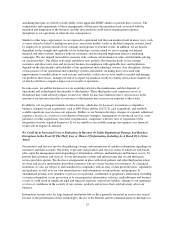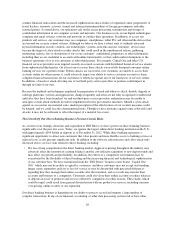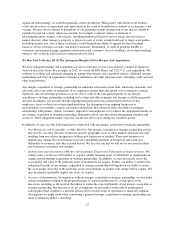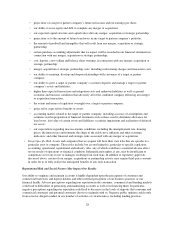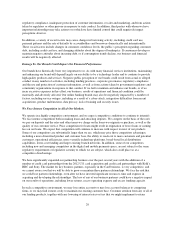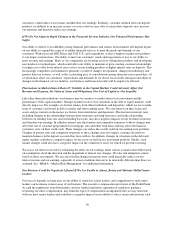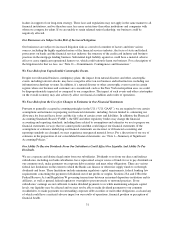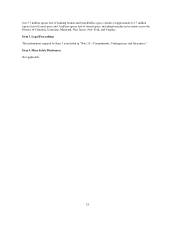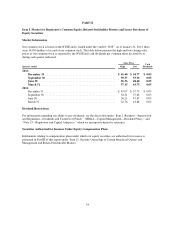Capital One 2012 Annual Report Download - page 43
Download and view the complete annual report
Please find page 43 of the 2012 Capital One annual report below. You can navigate through the pages in the report by either clicking on the pages listed below, or by using the keyword search tool below to find specific information within the annual report.requirements would increase our liquidity requirements and associated compliance and operational costs.
The Federal Reserve also indicated that it plans to adopt a capital surcharge for certain larger institutions,
but it is not clear to what extent the capital surcharge would apply to us.
• In November 2011, the Federal Reserve finalized capital planning rules applicable to large bank holding
companies like us (commonly referred to as Comprehensive Capital Analysis and Review or CCAR). Under
the rules, bank holding companies with consolidated assets of $50 billion or more must submit capital plans
to the Federal Reserve on an annual basis and must obtain approval from the Federal Reserve before making
most capital distributions. The purpose of the rules is to ensure that large bank holding companies have
robust, forward-looking capital planning processes that account for their unique risks and capital needs to
continue operations through times of economic and financial stress. As part of its evaluation of a capital
plan, the Federal Reserve will consider the comprehensiveness of the plan, the reasonableness of
assumptions and analysis and methodologies used to assess capital adequacy and the ability of the bank
holding company to maintain capital above each minimum regulatory capital ratio and above a Tier 1
common ratio of 5% on a pro forma basis under expected and stressful conditions throughout a planning
horizon of at least nine quarters.
• The Basel II final rules as implemented in the United States are mandatory for those institutions with
consolidated total assets of $250 billion or more or consolidated total on-balance-sheet foreign exposure of
$10 billion or more. We became subject to these rules at the end of 2012 primarily as a result of the
acquisition of ING Direct. Prior to full implementation of the Basel II framework, organizations must
complete a qualification period of four consecutive quarters, known as the parallel run, during which they
must meet the requirements of the rule to the satisfaction of their primary U.S. banking regulator. We are
preparing to enter parallel run January 1, 2015. This will require completing a written implementation plan
and building processes and systems to comply with the rules. Compliance with the Basel II rules will require
a material investment of resources. In addition, although we have current estimates of risk weight
calculations, there remains uncertainty around future regulatory interpretations of certain of those
calculations. Therefore, we cannot assure you that our current estimates will be correct and we may need to
hold significantly more regulatory capital than we currently estimate in order to maintain a given capital
ratio.
See “Item 1. Business—Supervision and Regulation” for additional information.
We Face Risk Related To Our Operational, Technological And Organizational Infrastructure.
Our ability to grow and compete is dependent on our ability to build or acquire necessary operational,
technological and organizational infrastructure. We are in the process of completing significant development
projects to complete the systems integration of prior acquisitions and to build a scalable infrastructure in both our
Retail Banking and Commercial Banking businesses. For example, we are investing in infrastructure in the
Commercial Banking business intended to assist with effective execution of key analytical processes and
improve loan origination and underwriting platforms. In addition, we have made and anticipate continuing to
make additional infrastructure changes and upgrades in connection with the integrations of both the ING Direct
and 2012 U.S. card acquisitions. The 2012 U.S. card acquisition involved the transfer of intellectual property,
servicing platforms, infrastructure, contact centers and a significant number of employees. The decoupling and
transitioning of these assets, infrastructure and systems from HSBC’s current systems and operations and
integrating them into our own business operations has been, and we expect it to continue to be, a highly complex
process. These infrastructure changes, upgrades and integrations may cause disruptions to our existing and
acquired businesses, including, but not limited to, systems interruptions, transaction processing errors,
interruptions to collection processes and system conversion delays, all of which could have a negative impact on
us. In addition, we have entered into numerous transitional service arrangements with HSBC entities that will
provide for services associated with the decoupling and transition of the business. Under these arrangements,
HSBC provides certain services to us and we provide certain services to HSBC. These transitional service
arrangements will continue for various dates until the separation of the business from HSBC is complete,
24




